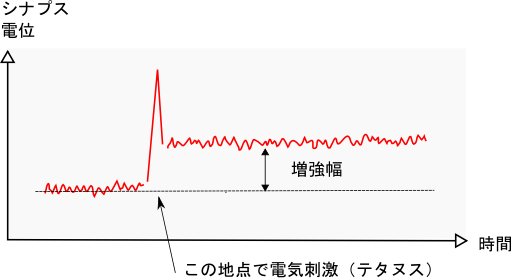Continuation of memory
Long-term potentiation (long-term potentiation:LTP)
There are two types ;early long-term potentiation (early LTP) and late long-term potentiation (late LTP).
The inner structure of the hippocampus is divided into dentate gyrus, hippocampus, and Ammon's angle (CA1, CA3) according to how the nerves gather, but when the hippocampal dentate gyrus synapses are stimulated at high frequencies, synaptic transmission Efficiency goes up and that rise goes on for a while.
This phenomenon was named as Long-Term Potentiation.
By inserting electrodes into the hippocampus, nerve cells are stimulated at a high frequency of hundreds of times per second, and nerve cells are strongly activated. Then, the synaptic potential instantly increases, and then the potential continuously increases instead of returning to the original potential.
This increased potential lasted for hours to days. This is long-term augmentation (LTP).
The high-frequency electrical stimulation that causes this LTP is called tetanus.

When the hippocampus is given tetanus once, the synaptic potential increases instantly and maintains its level. This means that synapse remembers the input of tetaneus. This is actually a memory mechanism.
The fact that a person remembers something means that the stimulus is transmitted to the hippocampus as an electrical signal, LTP occurs in nerve cells of the hippocampus, and the increased potential part becomes memory.
Quoted from http://yorokobuya.com/index.php?%E9%95%B7%E6%9C%9F%E5%A2%97%E5%BC%B7
When the stimulus exceeds a certain range,?it occurs in the order of?early LTP?and?late LTP?.In particular, late LTP seems to require gene expression.。
| It is not necessary to recognize and memorize all that occur around us, so we use different levels of recognition depending on the frequency and strength of the stimulus received, and strengthen synaptic connections as necessary, that is, we are creating memory. |
On the other hand, the opposite phenomenon happens.
In other words, it is a long-term depression (LTD) in which synaptic transmission efficiency decreases. Long-term repression plays an important role in motor learning, which is mainly controlled by the cerebellum.
Motor learning is movement memorized by exercise, such as walking and swimming. It is a non-declarative memory,which is mainly shared by the cerebellum, and is carried by nerve cells called Purkinje cells. Purkinje cells have large dendrites that extend like a maze at the tip.
Two nerve fibers , parallel fibers and climbing fibers, are connected to this dendrite , Information comes from parallel fibers and synapses are strengthened. That is The input to the Purkinje cells increases with each training.
However, if the body move in the wrong way, the climbing fiber will input an error message via the synapse as telling like "The movement is wrong."
At that time, it seems that the transmission efficiency of the synapse connected to the parallel fiber transmitting the wrong movement is reduced, and the synapse causing the error is removed from the neural circuit.
The climbing fiber teach it like"Do not remember this." In other words, we are learning by suppressing signals that we do not want to convey, as it suppress incorrect movements instead of increasing correct movements.

